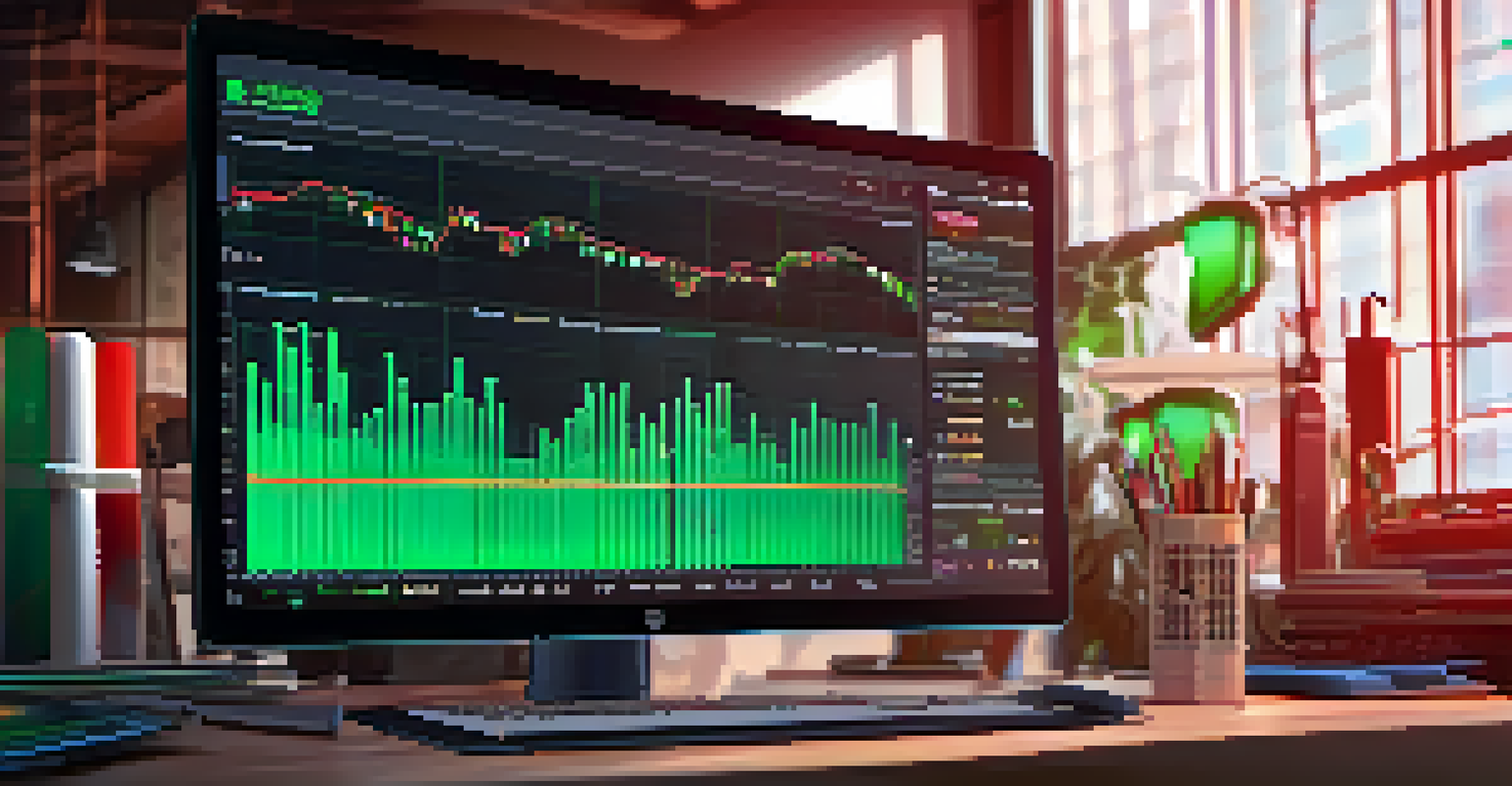NFT Market Volatility: Speculative Behaviors and Their Impacts

What Drives NFT Market Volatility?
The NFT market is notoriously volatile, with prices fluctuating wildly from day to day. This volatility often stems from external factors such as market trends, investor sentiment, and technological advancements. Just like stocks, NFTs can be influenced by news cycles, social media hype, and even celebrity endorsements, leading to rapid price changes.
In the world of cryptocurrency and NFTs, the only constant is change.
For instance, if a famous artist releases a new collection, you might see a spike in interest and prices for similar NFTs. Conversely, negative news or a market correction can cause panic selling, further exacerbating the volatility. It's a bit like a rollercoaster ride – thrilling, but also unpredictable.
Understanding these drivers is crucial for anyone looking to navigate the NFT landscape. By keeping an eye on trends and shifts in public interest, investors can better anticipate changes in the market and make informed decisions.
The Role of Speculation in NFT Prices
Speculation plays a significant role in the NFT market, often leading to inflated prices. Many investors purchase NFTs not just as art or collectibles, but with the hope that their value will skyrocket in the future. This speculative behavior can create a bubble effect, where prices rise rapidly based on hype rather than intrinsic value.

Take, for example, the surge in popularity of digital art during the pandemic. Some pieces sold for millions, driven more by investor speculation than the actual demand for the art itself. This phenomenon can lead to significant market corrections when reality sets in, leaving many investors holding assets that have lost value.
NFT Market Volatility Drivers
Factors such as market trends, investor sentiment, and speculation significantly influence the unpredictable nature of NFT prices.
Ultimately, speculation can be both a blessing and a curse. While it can drive initial interest and investment into the NFT space, it can also create instability and disillusionment when prices inevitably fall.
Understanding Collectors vs. Investors
In the NFT market, there's a clear distinction between collectors and investors. Collectors are motivated by a love for art and culture, often purchasing NFTs to enjoy personally, while investors are primarily focused on financial gain. This difference can lead to contrasting behaviors during periods of market volatility.
Investing in NFTs is like riding a wave; you must learn to balance excitement with caution.
For collectors, a drop in value may not be as concerning because their primary goal is enjoyment, not profit. On the other hand, investors may panic during a downturn, leading to rushed decisions and further volatility. This dynamic adds another layer of complexity to the NFT market, making it essential to understand your own motivations.
Recognizing where you fit into this spectrum can help guide your strategy in the NFT space. Whether you’re collecting for passion or investing for profit, your approach will shape how you respond to market fluctuations.
The Impact of Whales on NFT Markets
In the NFT ecosystem, 'whales' are individuals or entities that hold a large amount of valuable NFTs. Their buying and selling decisions can significantly impact market dynamics, often leading to dramatic price swings. When a whale suddenly decides to sell a collection, it can lead to panic among smaller investors, causing prices to plummet.
Conversely, when whales make large purchases, it can create a sense of legitimacy and increase demand for certain projects. This influence can be likened to a celebrity endorsement in traditional markets – their actions can sway public perception and interest dramatically.
Collectors vs. Investors Mindset
Understanding the difference between collectors, who buy for enjoyment, and investors, who seek financial gain, is essential during market fluctuations.
Understanding the role of whales can help investors strategize better. By monitoring whale activity, one might gauge market sentiment and anticipate potential shifts in prices, which can be crucial for making informed investment decisions.
Market Sentiment and Its Fluctuations
Market sentiment is a powerful force in the NFT world, often dictating short-term price movements. When sentiment is high, driven by excitement or new developments, you may see a surge in purchases and prices. However, when fear or uncertainty creeps in, the opposite can occur, leading to rapid declines.
This sentiment is influenced by a variety of factors, including community engagement, news coverage, and social media discussions. For example, an active online community can foster a positive sentiment, encouraging more buyers to enter the market. On the flip side, negative press can trigger a wave of selling, impacting prices significantly.
Being attuned to market sentiment can provide valuable insights for investors. By gauging the mood of the community and monitoring discussions, one can better navigate the often-choppy waters of NFT investing.
The Psychological Factors Behind Buying Decisions
Psychology plays a crucial role in the NFT market, influencing both buying and selling behaviors. Factors such as FOMO (fear of missing out), social proof, and emotional attachment can drive individuals to make impulsive decisions. For instance, seeing a friend purchase a high-priced NFT may trigger a desire to join in, regardless of the underlying value.
This psychological aspect can lead to herd behavior, where a group of investors collectively drives up prices based on emotion rather than rational analysis. It's essential to recognize these tendencies, as they can lead to overvaluation and eventual correction when the excitement fades.
Whales Shape Market Dynamics
Large NFT holders, known as 'whales,' can create dramatic price swings through their buying and selling actions, impacting smaller investors.
Being mindful of these psychological factors can help investors make more rational decisions. By focusing on personal goals and values rather than external pressures, one can better navigate the emotional landscape of NFT investing.
Strategies for Navigating NFT Volatility
Navigating the volatile NFT market requires a strategic approach. One effective strategy is to diversify your portfolio, spreading your investments across different types of NFTs and projects. This can help mitigate risk and cushion the impact of any single asset's decline in value.
Additionally, setting clear goals and defining your investment strategy can provide a roadmap amidst the chaos. Whether you’re looking for long-term appreciation or short-term gains, having a plan can help you stay focused and avoid impulsive decisions based on market fluctuations.

Finally, staying informed about market trends and maintaining a level head during downturns is crucial. By keeping emotions in check and focusing on data and research, investors can make more informed choices and potentially thrive in a volatile environment.